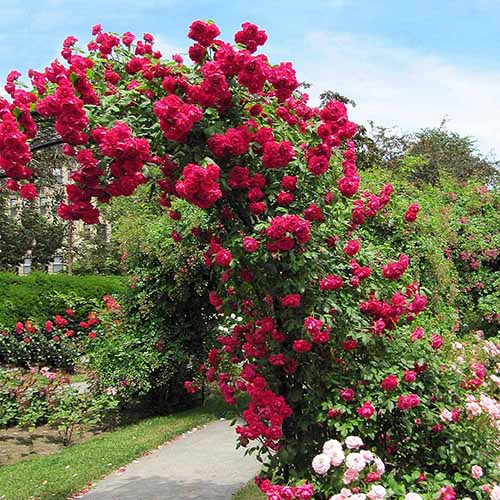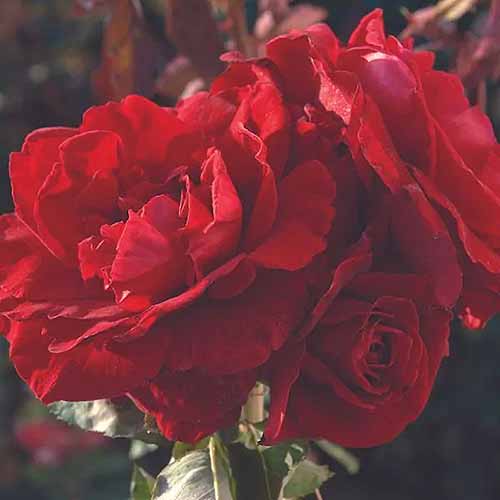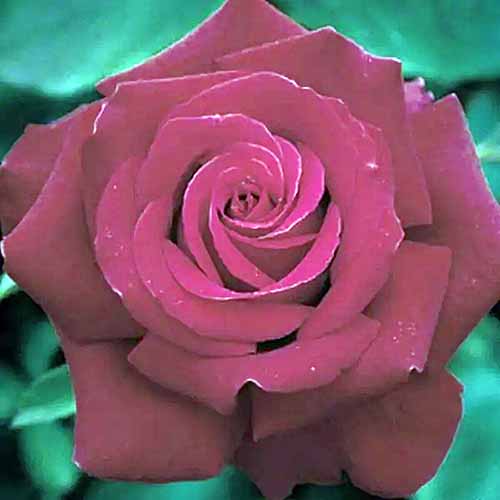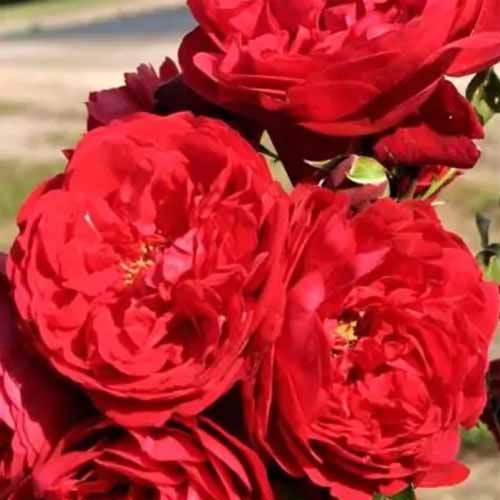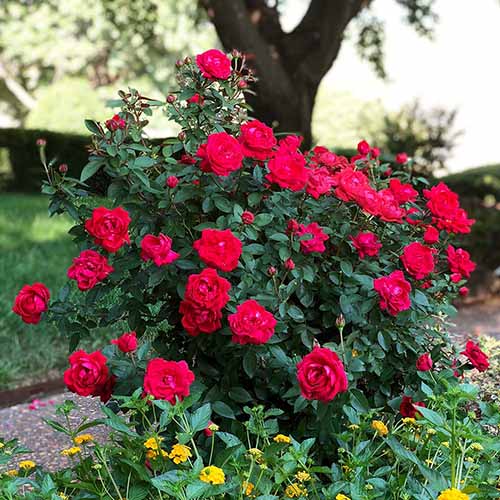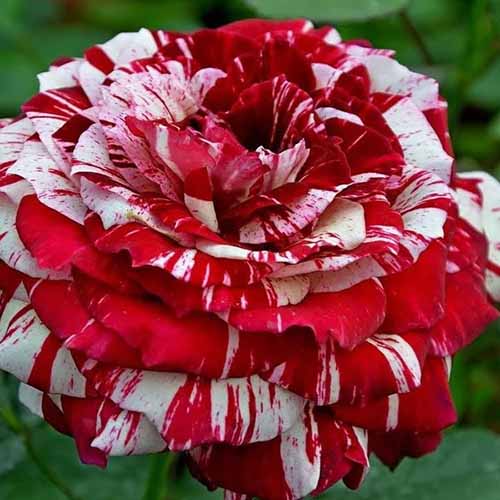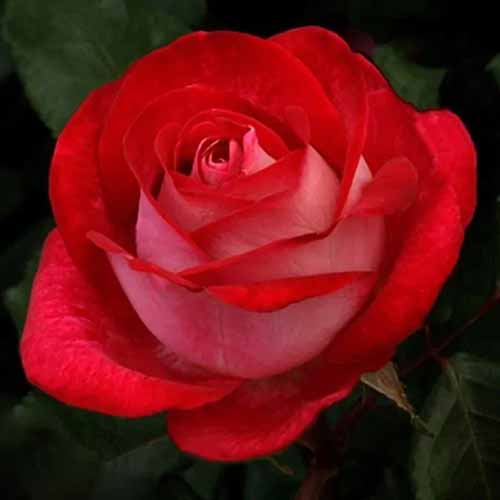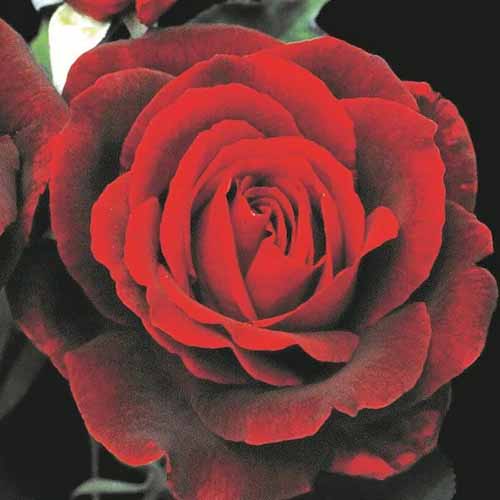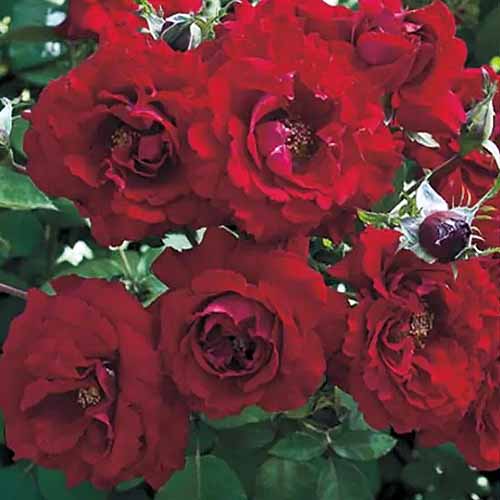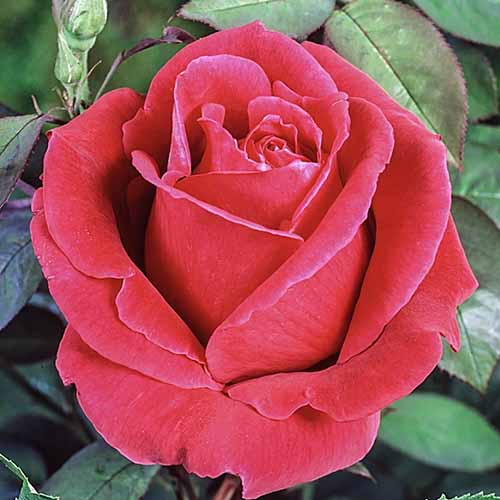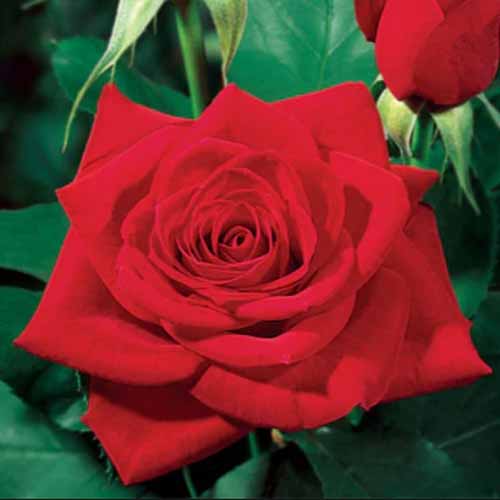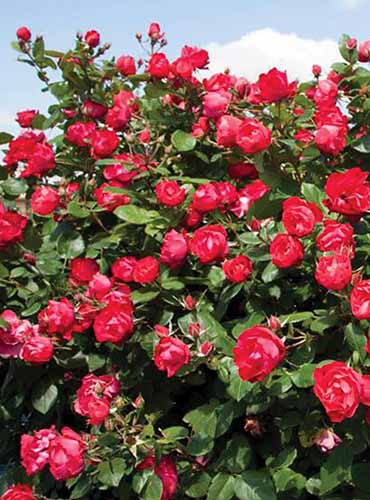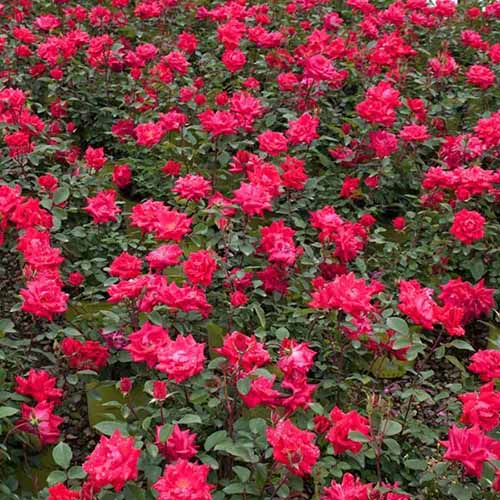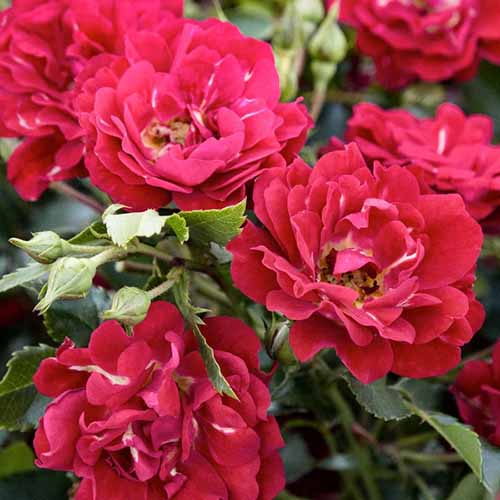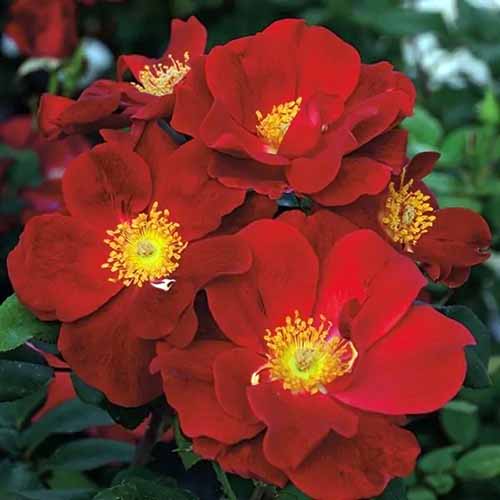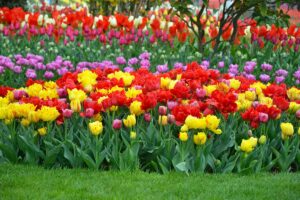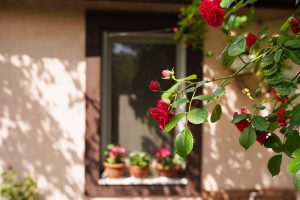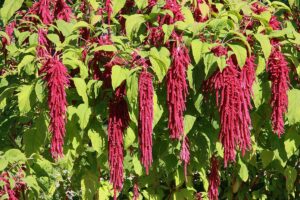The red rose is a classic that represents romance and desire. What would Valentine’s Day be without a dozen of them, and is any rose lover’s garden complete without a red rose or two?
Of course, there are a lot of options out there, from climbers that will cover a fence or cling to a wall to ground covers that will add interest to a sunny patch of the garden.
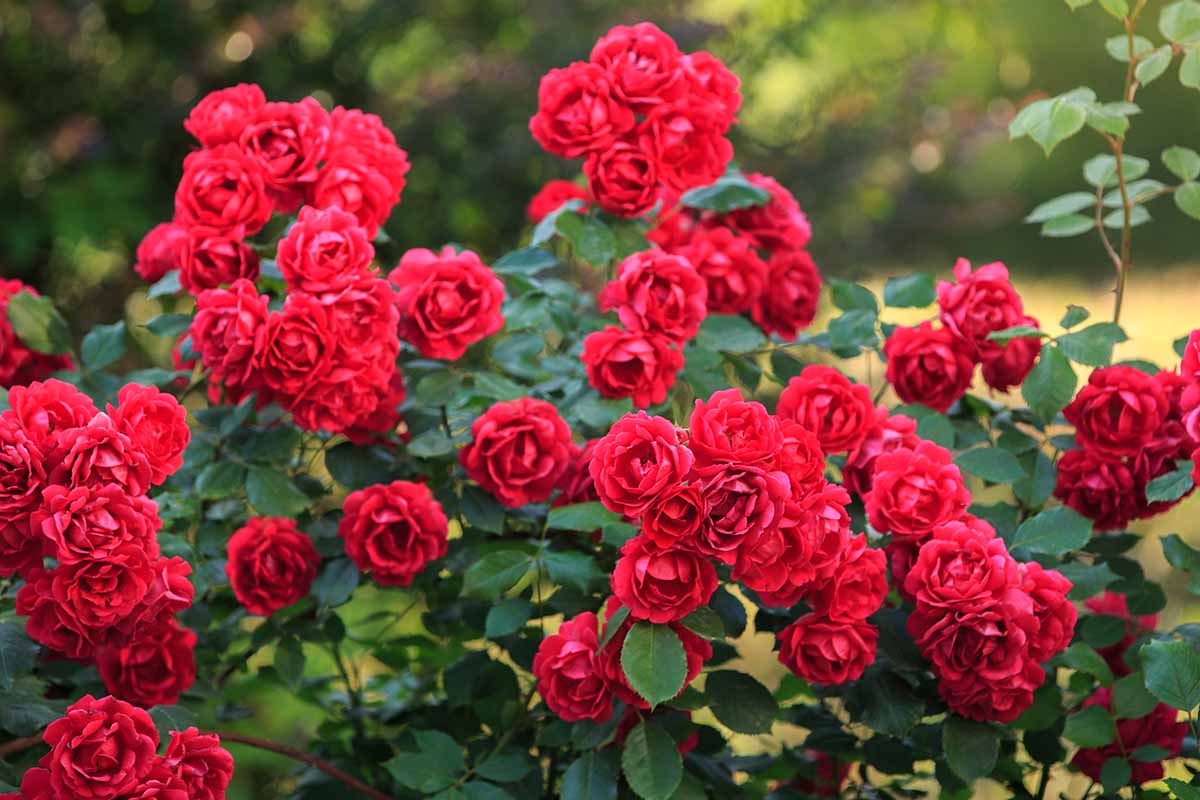
We link to vendors to help you find relevant products. If you buy from one of our links, we may earn a commission.
If you like simple, single blossoms, you’ve got options, and if you prefer the big, frilly flowers, there are plenty of those to choose from as well.
In this guide, we’ll give you those and more, from fragrant climbers to modest shrubs and everything in between.
Here’s the list of my very favorite red roses, coming right up:
Best Red Rose Varieties
Before we look at some of these stunning varieties, let’s clarify a few terms.
When we talk about blossom size, “small” refers to flowers under four inches in diameter, “medium” are four to five inches, and “large” are five inches or more.
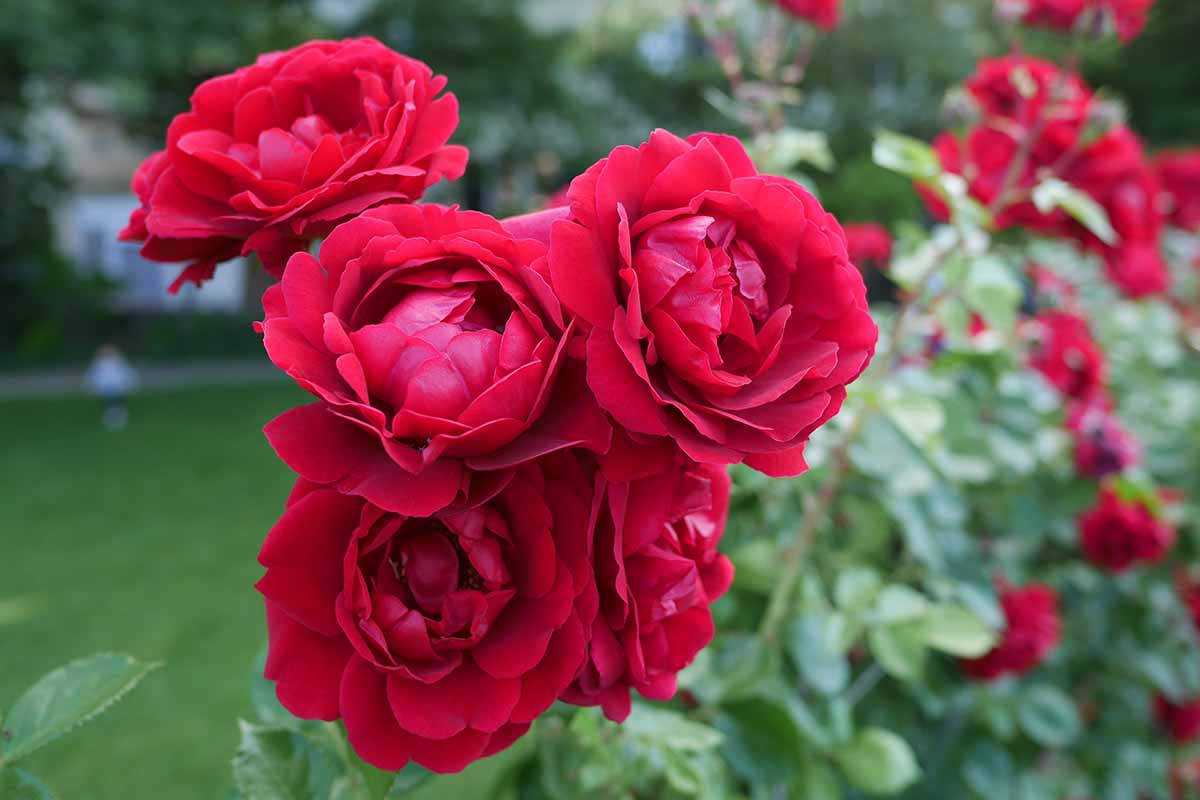
Blossoms are also categorized by the number of petals which determines how “full” the flowers appear. Singles have four to eight petals, semi-double have nine to 16, double have 17 to 25, full have 25 to 40, and very full have 41 or more petals.
We’ll also note which of these rose varieties bloom in flushes and those that are continual bloomers. The former are those that produce a whole bunch of flowers all at once and then stop blooming for a few weeks before another round of blooms appears.
Continual bloomers will have fewer flowers, but they will be present throughout the growing season.
To familiarize yourself with the different rose classifications, read our comprehensive guide to learn more about the difference between a floribunda and a miniflora rose.
If you need cultivation details, our guide to growing roses has you covered.
With that out of the way, let’s dive into our list of the best red roses for your garden! Let’s start with one of my favorites:
1. Alec’s Red
I can highly recommend ‘Alec’s Red,’ aka Rosa ‘COred.’
The buds on this four-foot-tall hybrid tea shrub rose start out so dark that they appear almost black. As the large, full flowers open, the petals show their true cherry hue.

As if that wasn’t enough, the blooms have a heady damask fragrance and appear constantly from late spring to the first frost.
It’s a lovely container or border option for Zones 5b to 10b.
2. Benjamin Britten
The David Austin shrub ‘Benjamin Britten’ (aka R. ‘AUSencart’) is a repeat bloomer, which is always welcome, but what makes it really shine is the ever-changing color of the flowers.
The medium-sized, very full flowers start out orangish-red when they first open but gradually shift to pure red and then pinkish-red as they fade.
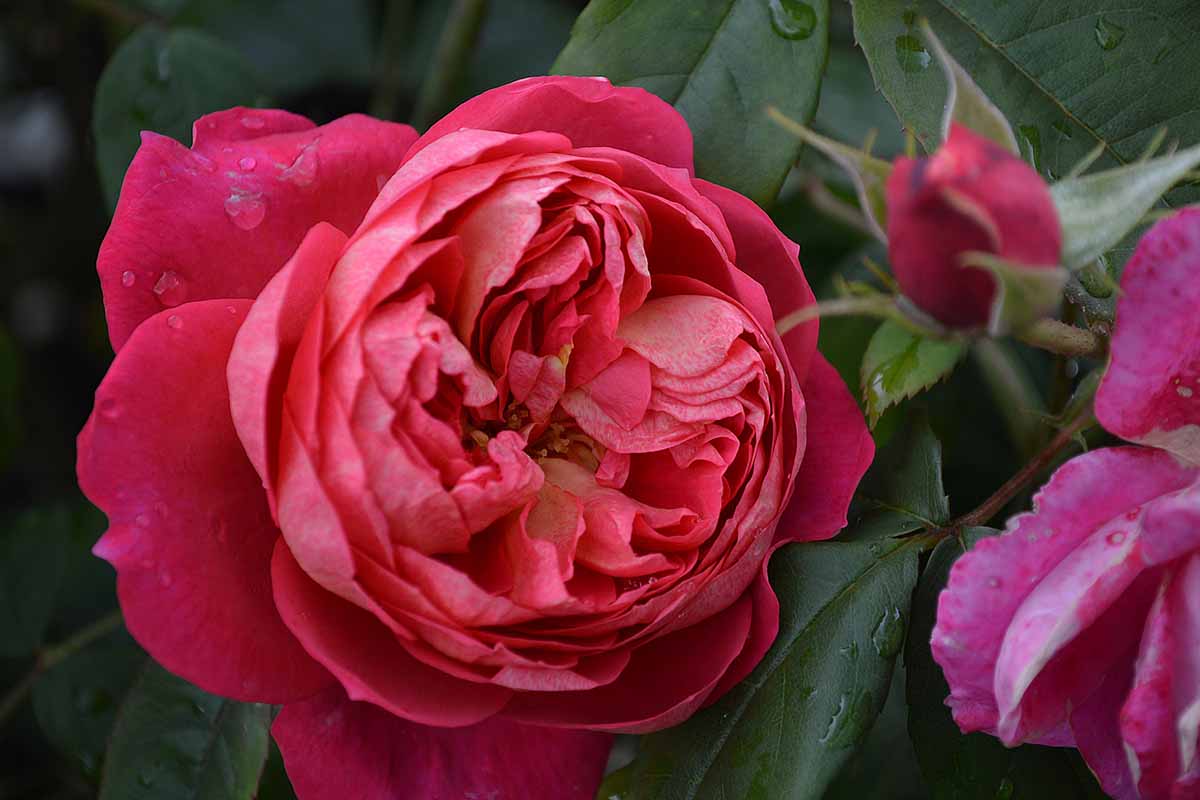
The fragrance is stunning, like a mixture of fruit and wine.
‘Benjamin Britten’ has a dense growth habit and tops out at about four and a half feet tall. It’s hardy in Zones 4 to 11.
The downside is that the flowers can tend to ball if you experience wet spring weather.
3. Black Beauty
Georges Delbard, a well-known breeder in France, bred this blood-red hybrid tea in 1973 and it has remained a favorite for gardeners who want a rose with blossoms so dark they’re nearly black.
The buds are nearly black, as well. The four-foot-tall shrub blooms in flushes with large, double flowers all season in Zones 6 to 10.
It’s ideal as a cut flower for your gothic sweetheart, in containers, or as a garden specimen.
4. Blaze Improved
If you’re looking for a classic floribunda climber, R. ‘Demokracie,’ better known as ‘Blaze Improved,’ has a lot to offer.
This one features large double flowers in small clusters that appear in flushes throughout the growing season without any deadheading.
Given a support to climb, it can stretch up to 15 feet tall and given the moderate floral fragrance of the crimson blossoms, it makes quite the statement.
It was brought to us by breeder Jan Böhm of the former Czechoslovakia in 1935, and introduced by Jackson & Perkins in 1950. ‘Blaze Improved’ thrives in Zones 5 to 9.
It’s easy to see why this is one of the most popular crimson climbers, and you can find one of your own at Fast Growing Trees in a three-gallon container.
5. Braveheart
‘Braveheart’ was bred by noted rosarian and Small World Miniature Roses founder John Clements of St. Paul, Oregon.
He started breeding in the late 1970s with a focus on English roses to create fragrant and disease-resistant specimens.

This shrub type hit the market in 1998 with four-inch, double flowers with the classic bloom shape. It is a repeat bloomer in Zones 5b to 10b and grows up to three feet tall.
The blood-red petals are velvety with a moderate fragrance and the flowers appear in repeated flushes throughout the summer.
6. Bright Melody
Before we talk about this rose, I want to mention a bit about the breeder Griffith Buck. We have an entire guide about Dr. Buck and his roses, but I’ll do a little recap here.
Dr. Buck was a professor and horticulturist at Iowa State University in the 1940s and 50s.
He bred roses with the goal of creating hardy, disease-resistant plants, and he did this by propagating the plants in his Iowa garden and then weeding out any that failed to thrive without chemical intervention or coddling.
He also wanted the roses he bred to be repeat bloomers.
His first commercial success was ‘Carefree Beauty,’ bred in the 1970s, and after that many other cultivars became popular.
Because he didn’t turn to the large commercial growers or patent his roses, he never achieved the big-name status of some of the brands out there, but you better believe his plants are every bit as marvelous.
More so, if you ask me, because you can use them to breed, and they’re much more beautiful than a certain common brand also known for being easy to care for.
That brings us to ‘Bright Melody,’ which sings with medium-sized, bright ruby-red flowers that appear continually on the four-foot-tall hybrid tea, singly or in groups of up to 25. It’s hardy in Zones 4b to 10.
The double flowers have a moderate floral fragrance, similar to its parent ‘Carefree Beauty.’
7. Don Juan
Hybrid tea ‘Don Juan’ was hybridized in 1958 by breeder Michele Malandrone and introduced to the United States in 1959 by Jackson & Perkins, who knew they were onto something good with this beauty.
Climbing 14 feet or so tall, it’s covered in deep crimson, large, very full flowers that appear in flushes throughout the growing season in Zones 6b to 9b.
The blossoms have a heavenly fragrance of old rose and raspberry, and while it’s one of the best red climbers, the long stems also lend themselves nicely to cutting.
You can find ‘Don Juan in #3 containers available from Nature Hills Nursery.
8. El Catala
Another beautiful offering from Dr. Griffith Buck, ‘El Catala’ is a bicolored hybrid tea shrub with ‘Wanderin’ Wind’ parentage, released in 1981.
The petals are raspberry red with silver undersides, giving the plant a striking appearance.
Hardy in Zones 5b to 10b, the three-foot-tall shrub blooms in continual flushes throughout the year, with the flowers appearing in groups of up to eight.
It has a mild fragrance, but it’s the bicolored petals that really make these flowers sing.
9. Firefighter
Firefighter® (R. ‘ORAdal’) is a bold hybrid tea with large, fully double, velvety blooms.
With few thorns and long canes, it’s perfect for cut flower arrangements and blooms continuously throughout the season, so you never have to go without.
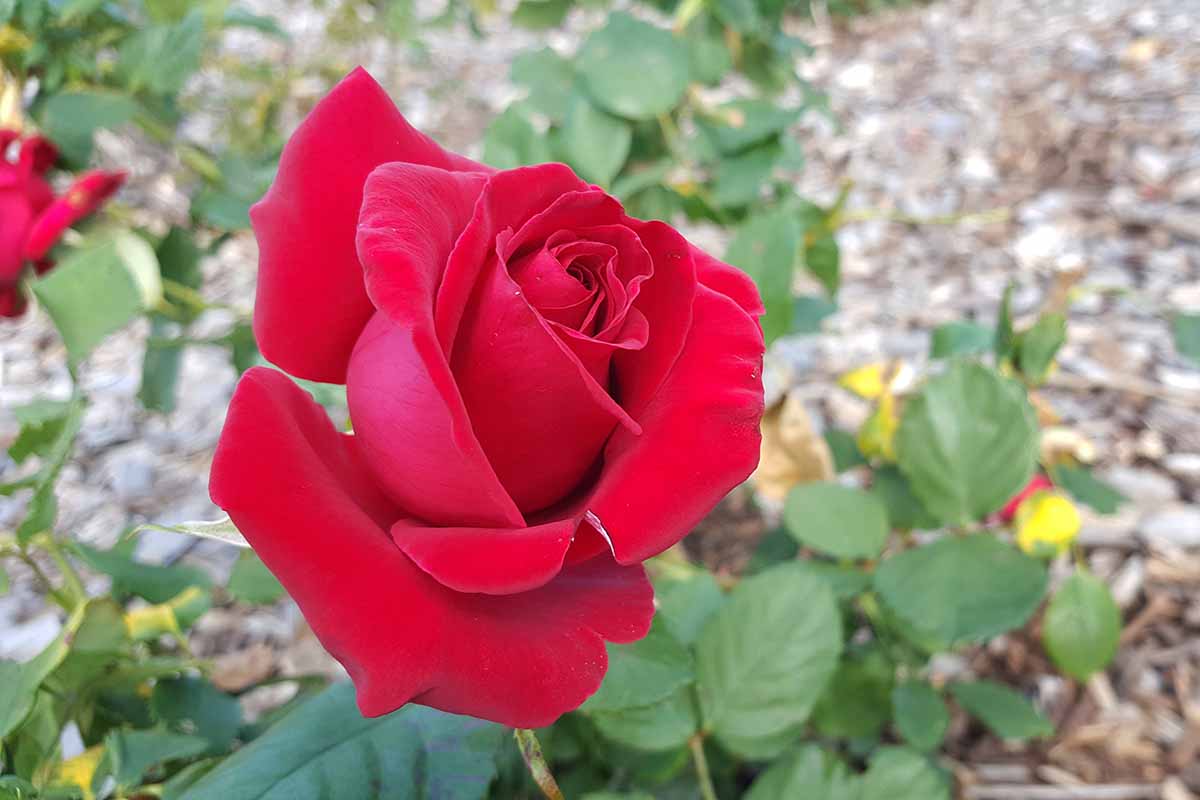
Created by breeder Joseph Orard in France, this cultivar was introduced to the US by Edmunds’ Roses.
The full flowers have petals that are darker on the top and slightly lighter on the undersides. They also have a strong strawberry, musk, old-rose fragrance.
It’s hardy in Zones 6 to 10, with the ability to withstand hot weather and fungal disease on an attention-grabbing six-foot-tall shrub.
Named after the first responders who lost their lives in the September 11, 2001 attacks, it’s a beautiful way to pay homage to the selfless people who sacrifice themselves for others.
You can find Firefighter® available at Nature Hills Nursery.
10. Florentina
Florentina™ Arborose® (R.’KORtrameilo’) comes from Kordes Roses and was bred by Tim Hermann Kordes in 2002 from two unnamed seedlings.

The medium-sized flowers are raspberry red and very full with over 70 petals each. The outer petals are smooth and the inner ones are curled and ruffled around yellow stamens.
While this climber usually only blooms once in the late spring or early summer, it may sometimes rebloom later in the year.
When in bloom, the plant is so completely covered that you can hardly see the foliage underneath the flowers.
This cultivar is resistant to fungal diseases like black spot and powdery mildew, hardy in Zones 5 to 9, and a polite climber that creeps up to nine feet tall.
Its smaller size, for a climber, makes it perfect for growing in containers or smaller spots. Sound good? You can find Florentina™ Arborose® available at Nature Hills Nursery.
11. Francois Rabelais
The very full, cupped flowers of ‘Francois Rabelais’ appear in large clusters on a petite two- to three-foot-tall shrub.
While they lack fragrance, the old-fashioned blossoms are a deep ruby red, and bloom in flushes throughout the season.
Bred by Meilland Roses, this floribunda is hardy in Zones 6b to 10b and is extremely mildew resistant.
The long, straight canes only have light prickles, making it perfect for cutting and flower arrangements.
12. Grand Champion
Meilland Roses can always be counted on for robust beauty, and ‘Grand Champion’ (aka R. ‘Meimacota’) does not disappoint.
The medium-sized, very full crimson blossoms on a four-foot-tall shrub create an eye-catching background for a bed full of annuals or alone as a specimen planting.
The mildly fragrant blossoms appear in flushes throughout the growing season even during mild drought or extreme heat.
It won’t be troubled by fungal diseases and doesn’t need any deadheading to look its best.
You can find this winner in three-gallon pots available at Fast Growing Trees.
13. Griff’s Red
‘Griff’s Red’ is one of Dr. Griffith Buck’s most popular roses, as the red version of his perennial favorite ‘Carefree Beauty,’ and it’s easy to see why.
The velvet crimson petals are held in large, full blossoms that appear continually throughout the growing season with a strong sweet-spicy fragrance.
It’s exceptionally hardy north to Zone 4 and as far south as Zone 10 and, like all of Buck’s roses, is disease-resistant.
‘Griff’s Red’ grows up to four feet tall but typically stays a bit shorter. Even for the short period that it’s not in bloom, the glossy, deep green foliage is a treat.
14. Julio Iglesias
For something a little different, try ‘Julio Iglesias’ (‘Meistemon’). The petals are snow white or cream with fire engine red or mauve splotches and a strong, bright citrus fragrance.
The flowers are full, medium-sized, and appear in clusters throughout the season on a three-foot shrub.
The flowers have deeper, stronger coloring in bright, direct sun, so don’t grow this one in your partially sunny spots.
Whether you grow this floribunda as a tree, in a container, or in a small group, it’s going to draw all the attention in Zones 6 to 9.
Bring the party to your home and find ‘Julio Iglesias’ available at Planting Tree.
15. Kashmir
From the Easy Elegance® series, ‘Kashmir’ (R. BAImir) combines the disease-tolerance and ease of care of a modern rose with the appearance of a classic tea.
This shrub rose grows to just shy of three feet tall, with crimson, medium-sized, very full flowers.
The solitary flowers appear in flushes from spring to the first frost in Zones 4 to 9 and won’t fade or discolor in the heat. And the long stems make it easy to use them in cut flower arrangements.
If ‘Kashmir’ fits the bill, visit Nature Hills Nursery to bring one home.
16. Love at First Sight
It really is Love at First Sight™ (aka ‘WEKmedatasy’) when you see this cultivar.
The petals of this hybrid tea are true red with pink undersides, giving the very full, medium-sized flowers a textured appearance.
Each flower appears singly and the plant blooms in flushes from spring through fall.
This hybrid tea is a cross between Memorial Day™ and Take It Easy™and is a recent introduction, hitting the US market in 2019.
It has a very upright form and grows up to four feet tall, perfect for borders and containers.
Love at First Sight™is hardy in Zones 5b to 9b, and exhibits good disease resistance.
You can find Love at First Sight™ available at Nature Hills Nursery.
17. Mister Lincoln
It almost feels a little unfair to put ‘Mister Lincoln’ up against the crowd because this cultivar has been a consistent favorite for decades and it’s pretty hard to beat.
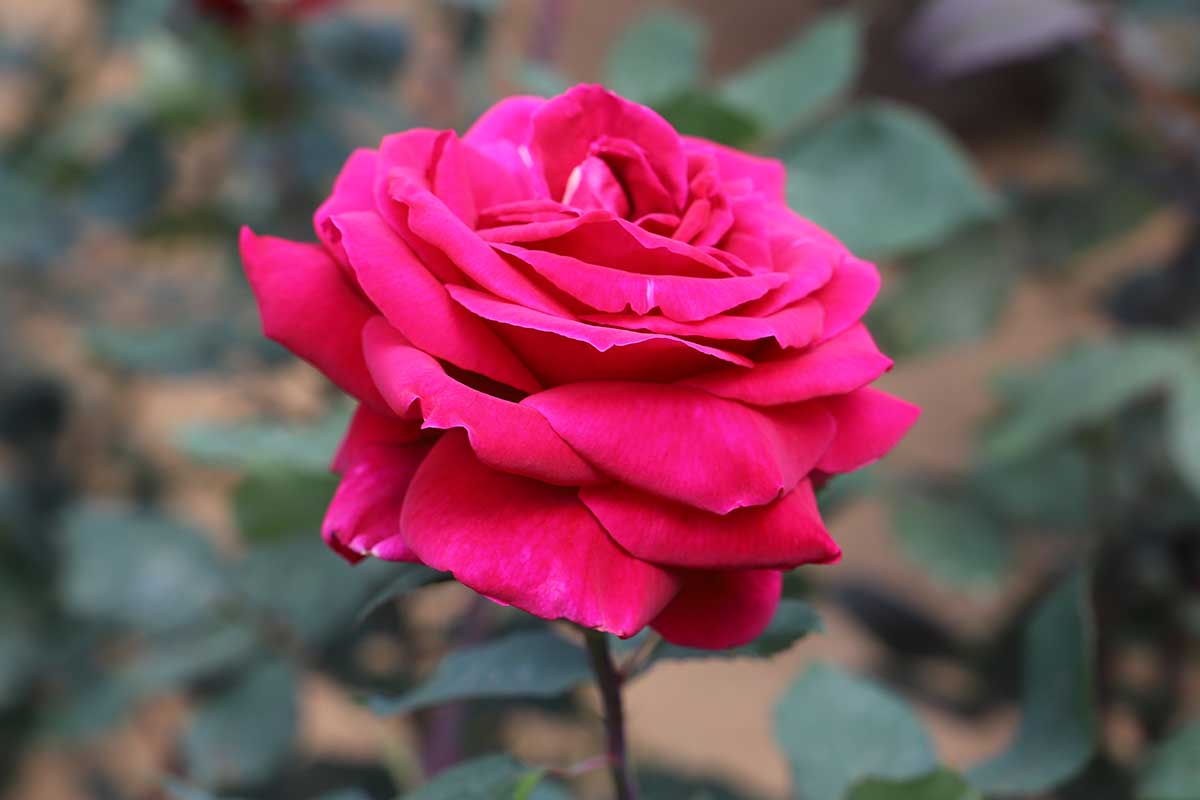
Named for the former US president, ‘Mister Lincoln’ is an extremely vigorous, disease-resistant shrub that tops out at about four feet tall in Zones 7 to 10.
The very full, large blossoms are deep burgundy and appear singly on long stems that are perfect for cutting, and reappear in flushes throughout the growing season.
Sun, heat, and rain won’t cause the flowers to fade or ball, and it’s so tough that beyond pruning, you can basically ignore this rose.
Except you won’t be able to because the heady damask fragrance commands attention.
If you want a hybrid tea that will always perform well with no muss and no fuss, ‘Mr. Lincoln’ should win your vote by a mile.
You can find this cultivar in #2 containers available at Nature Hills Nursery.
18. Munstead Wood
A favorite from David Austin, ‘Munstead Wood’ (R. ‘AUSbernard’) is a shrub with deep, dark, four-inch, very full flowers on a three-foot-tall plant.
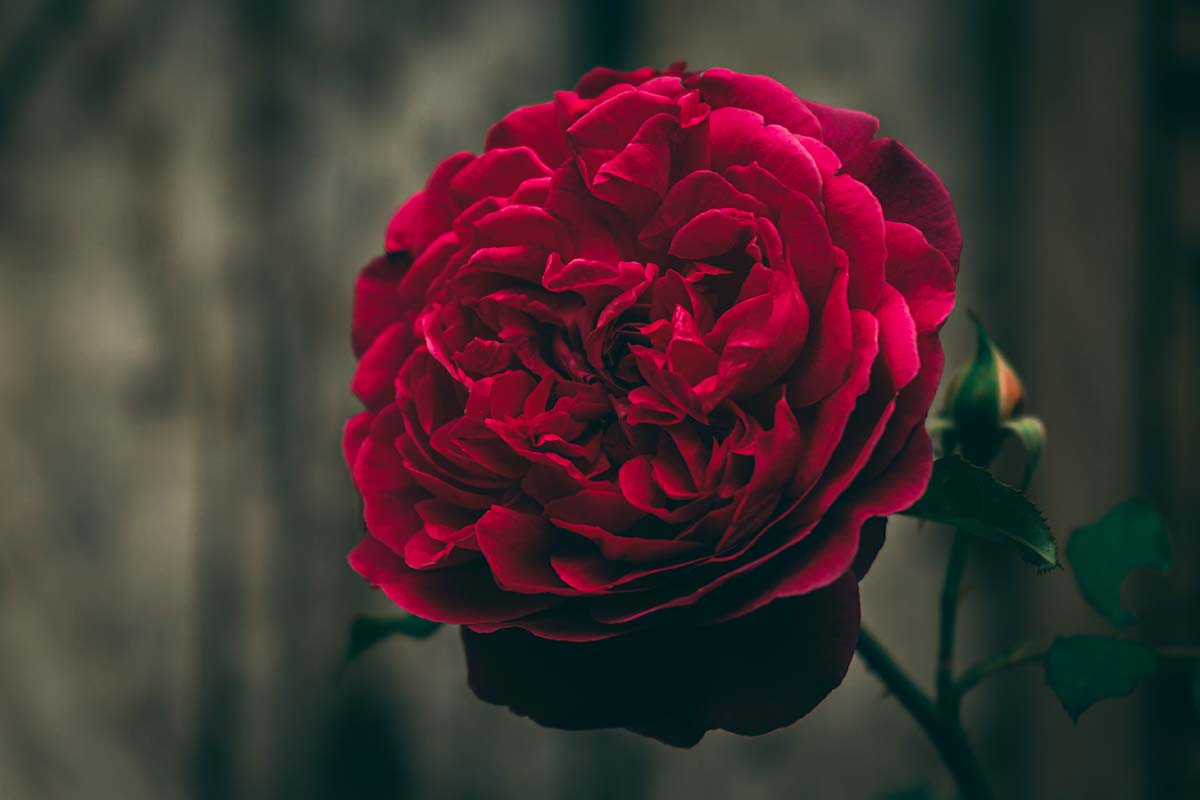
The outer edges of the petals are just a touch lighter than they are at the center, giving them a textured appearance.
The old-fashioned-looking flowers have a heady, classic rose fragrance with a hint of berry.
Grow it in Zones 5 to 11 in the ground or containers for a timeless touch.
19. Night Song
This is a melody that hums rather than shouts. The flowers are large and full and may be solitary or in small bunches that appear in flushes throughout the year.
The medium-sized bush grows to about four feet tall in Zones 5 to 10.
This is where the music swells. The petals are dark cardinal red with just a hint of white at the base, enclosing yellow stamens.
Punctuated against the glossy dark green foliage, it’s a top hit from Dr. Griffith Buck.
20. Oh My!
Bred by Christian Bedard and released by Weeks Roses in 2009, Oh My!™(R. ‘WEKcisfribo’) has deep, velvety ruby petals cupping golden anthers, all with a mild, spicy, rose fragrance.
The medium-sized double blossoms are borne singly and bloom continuously from spring through fall.
This floribunda type grows in Zones 4b to 10b, but the color and flowering are best in climates with coolish summers. It has exceptional disease resistance and tops out at about four feet tall.
You can find plants available at Nature Hills Nursery.
21. Oklahoma
With velvety petals so deeply colored that they’re almost maroon or black, depending on the light, ‘Oklahoma’ is a beautiful hybrid tea with a sweet, floral fragrance.
The large flowers appear repeatedly throughout the growing season on a commanding shrub that can grow up to eight feet tall. You can also treat it as a small climber if that’s your fancy.
Bred by Weeks Roses in 1964, ‘Oklahoma’ is a vigorous plant suitable for Zones 7 to 10 and exhibits excellent resistance to fungal diseases.
Additionally, it has long stems that make it suitable for a cutting garden.
Walmart carries this lovely option as a bare root.
22. Olympiad
For a true red with a classic rose look, the hybrid tea ’Olympiad’ aka ‘MACauck’ is the way to go.
The medium-sized, full blossoms appear singly on the five-foot-tall shrub in flushes from late spring to the first frost.
The fruity fragrance makes it a wonder as a cut flower in a vase or growing near your patio or garden bench.
‘Olympiad’ won the All-American Rose Selections honors category in 1984 and was featured at the Olympics that year. Grow it in Zones 5 to 8.
You can find ‘Olympiad’ available at Planting Tree.
23. Oso Easy Double Red
A cheerful, carefree Meilland offering, Oso Easy Double Red® has medium crimson double blossoms that grow in small clusters and appear in flushes throughout the season.
The shrub stays under three feet tall and lives up to its name with good disease resistance, no need for deadheading, and little pruning required.
The clusters are held on long stems, ideal for cutting, and this cultivar is cold hardy enough to thrive in Zones 4 to 9.
Nab yourself a live plant from Burpee.
24. Prairie Clogger
With petals the color of the deepest ruby offset by bright yellow stamens and deep copper and olive-green foliage, ‘Prairie Clogger’ grabs your attention.
It’s also a delight for the nose with its sweet, floral fragrance. The medium-sized flowers grow in clusters of up to 10 in repeated flushes from spring through the first frost.
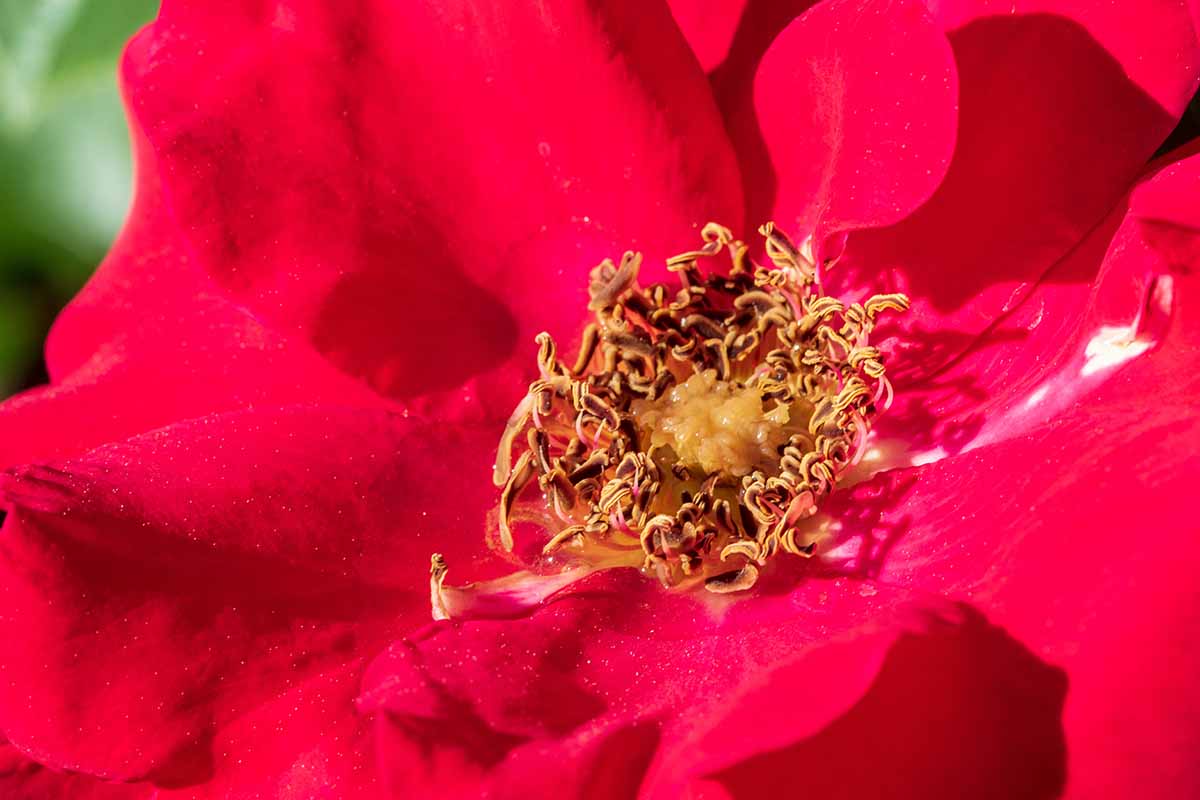
The four-foot shrub is resistant to fungal diseases and hardy in Zones 4 to 10.
‘Prairie Clogger’ is another offering from Griffith Buck, and you know how I feel about his roses. It’s a hybrid between his ‘Carefree Beauty’ and Kordes’ ‘Marlena’ x ‘Pippa’s Song.’
25. Red Double Knock Out
For a long time, the easygoing, disease-resistant Knock Out series of roses consisted of small shrubs with single blossoms. That was fine for those who didn’t crave the elegance of fuller flowers, but the rest of us were left out of the party.
But in 2004, ‘Radtko,’ commonly known as the Red Double Knock Out rose, roared onto the US market and quickly became a firm favorite.
The small to medium double blossoms are crimson with a mild spicy fragrance. The impact is made even more impressive as the flowers appear in large groups continuously from spring until the first frost.
Double Red Knock Out is also extremely tough, suitable for cultivation in Zones 4 to 9.
If you love the Knock Out series but want a more impressive display, this one is a TKO.
Nab one in a quart-sized or #3 container, or as a bare root from Nature Hills Nursery.
26. Red Drift
The Red Drift® rose (R. ’Meigalpio’) comes from Meilland Roses and has become a wildly popular option since its release in 2008 for those who crave a ground cover with ruby-colored blossoms.
The buds start out pinky-red but quickly transition to their mature shade on a short bush that tops out at 16 inches or so.
The small blossoms are semi-double and though they’re petite, they group together in large clusters that blanket the bush throughout the growing season.
Red Drift® is disease-resistant and hardy in Zones 4 to 10.
You can find plants in one-, two-, and three-gallon containers available at Planting Tree.
27. Red Eden
‘Red Eden’ (R. ‘MEIdrason’) was bred by Alain Meilland of Meilland Roses.
It’s a climber that sports clusters of large, full blossoms in deep crimson that appear in flushes throughout the season.
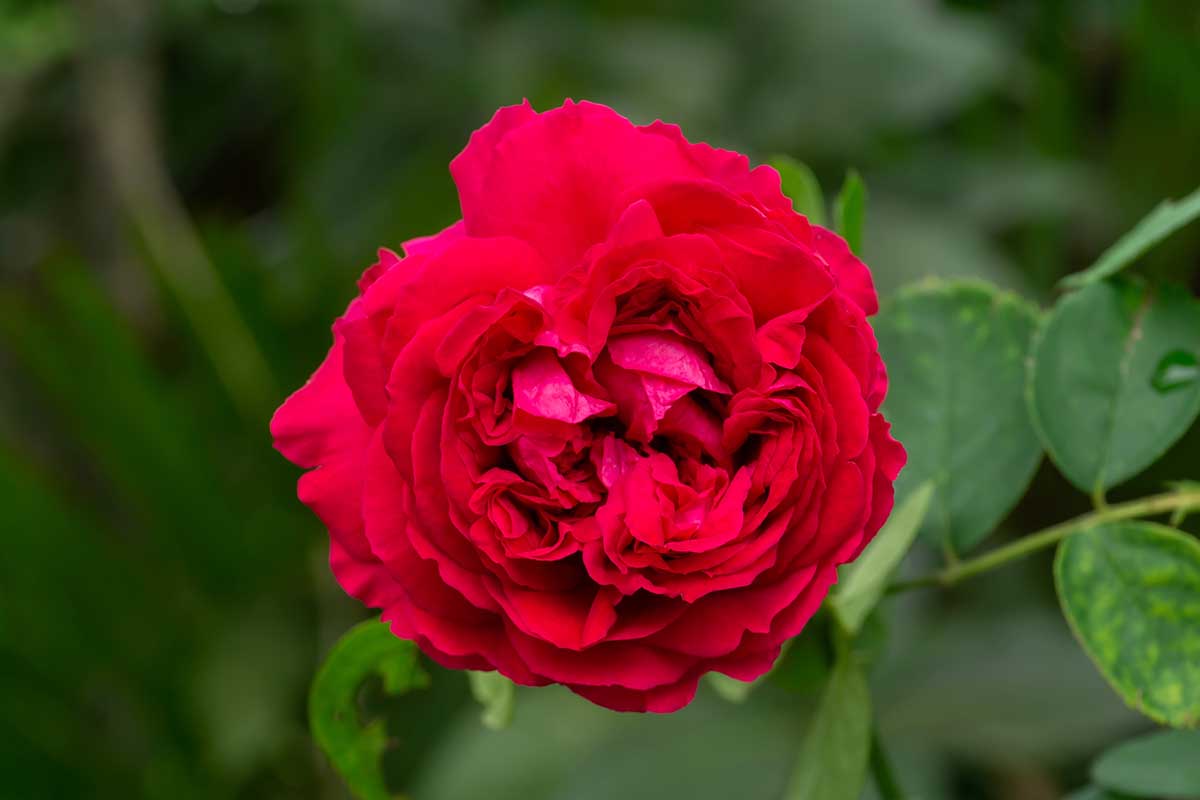
The old-fashioned blooms have smooth outer petals and ruffled inner petals held in cupped blossoms with a moderate fragrance.
Once the flowering season ends, the large orange hips add further ornamental interest.
The shrub can grow up to 15 feet long in Zones 6 to 9 but watch out if you live in an area prone to wet weather in spring, as this can cause the flowers to ball.
28. Showbiz
A classic crimson floribunda, Showbiz aka ‘TANweike,’ has medium, double blossoms that bloom in large clusters.
The petite shrub clocks in at just two feet tall, but it can be positively smothered in flushes of flowers that appear throughout the season.
That’s showbiz, baby! If you live in Zones 6 to 9, bring this superstar to your stage from Nature Hills Nursery.
29. Smokin’ Hot
Keep the fire extinguisher nearby, because ‘Smokin’ Hot’ (R. ‘WEKmopaga’) is bringing the fire.
With orange-red petals tinged in burgundy and pale pink on the undersides, it’s like staring into the embers of a wildfire.
This hybrid tea was bred by Christain Bedard and introduced by Weeks Roses in 2015, and while the flowers don’t have any fragrance, the plant makes up for it with deep burgundy-tinged foliage that smolders just as beautifully as the large, double flowers.
The four-foot-tall shrub thrives in Zones 4 to 10 and can be found at Nature Hills Nursery in #2 containers.
30. Top Gun
Better than Maverick pulling some incredible aerial stunts, R. ‘WEKmoridahor’ aka Top Gun™ is going to catch all the attention without all the muss and fuss (or annoying the Navy).
The vigorous shrub is extremely disease-resistant (including rose rosette disease!) and hardy in Zones 4b to 10a.
The ruby-red medium blossoms are semi-double, with a moderate fragrance of fruit.
It was bred by Tom Caruth and brought to market by Weeks Roses in 2018. It’s a favorite with gardeners and pollinators alike.
This plant is the perfect wingman for anyone who wants to enjoy deep red roses.
Nature Hills carries Top Gun™ in #3 containers.
31. Queen Bee
A rose fit for royalty, this Dr. Griffith Buck beauty has large double flowers with velvety, ruby-red petals cupping golden stamens.
This is one of the more fragrant offerings, with heavenly pungent notes of old rose and fruity raspberry coming from flowers that appear in clusters from late spring until first frost.
‘Queen Bee’ grows to about three feet tall and is hardy in Zones 5b to 9b without protection. It also makes an excellent cut flower plant.
32. Tess of the D’Urbervilles
If you’re looking for a classic climber, this David Austin repeat bloomer is one to look at.
The crimson flowers are large and very full, appearing in clusters. It grows to about eight feet tall and, watch out, it has a ton of prickles. Not to worry, the dense growth covers them in medium green leaves.
It was registered as ‘AUSmove’ in 2000 and grows in Zones 6b to 9b.
33. Thomas a Becket
This David Austin rose stands out from the other English types because it has a more natural, shrubby growth habit, topping out at about four feet tall.
The blossoms are full, cupped, and form in small rosettes throughout the growing season from early summer until the first frost.

The medium-sized nodding flowers have a lemony fragrance that is simply heavenly in the summer sun in Zones 5 to 9.
It’s the perfect option if you’d like a more natural-looking shrub that has all the benefits of a modern, disease-resistant plant.
My Love is Like a Red, Red Rose
There’s a reason red roses appear in both classic and modern art, bouquets, and gardens. They’re ravishing! Once you plant yours, you’ll be able to enjoy the splendor up close and personal.
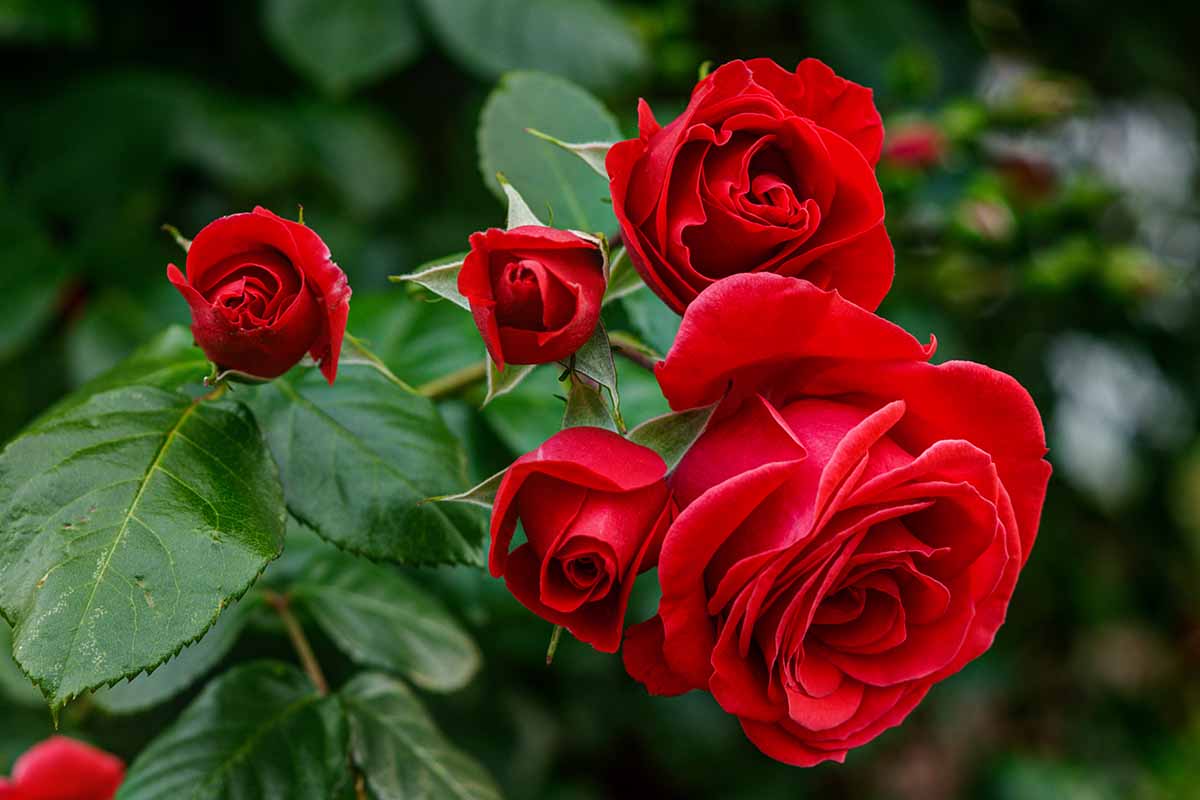
Now I need to hear from you. Is there a particular favorite of yours that I missed? Or do you have anything to add about one of the options I mentioned above? Let us know in the comments section below!
You think you’re done now that you’ve found the perfect option for your garden? Heck no! There’s so much more to explore in the world of growing roses! Check out these guides next:

